David King (President’s Award)
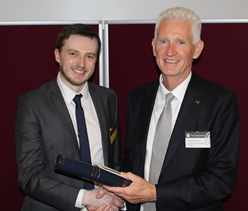 The first President’s Award today goes to David King of University College London.
The first President’s Award today goes to David King of University College London.
David is one of the brightest young stars of micropalaeontology, whose ability to examine museum collections made 50 years ago and integrate them with modern taxonomic and palaeoecological understanding, sets him apart. He is also conducting new analyses in morphometrics and stable isotope geochemistry. He is in the final year of his PhD currently, and several lead-author papers based upon his thesis are already in preparation; while his publication record to date includes a timely peer-reviewed paper that offers an explanation for a hitherto problematic stratigraphic event of great importance, based upon work he did for his Master’s thesis.
David King, you combine boundless enthusiasm with a breadth of knowledge more typical of a much more senior researcher. You have all the skills and attributes necessary to become a future leader in the field. Please receive the first President’s Award with our congratulations.
Oliver Rose (President’s Award)
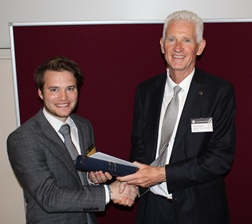
The second President’s Award goes to Oliver Rose, a Graduate Engineering Geologist with CH2M, now Jacobs Engineering Inc.
To date, Presidents’ Awards tend to have been given to young researchers who are still perhaps contemplating an academic career, so I am delighted that this year I have been able to make an award to a young engineering geologist who finished his Masters degree with a Distinction only a couple of years ago at Leeds University.
At CH2M, based on both his MSc and his excellent internship with the company, Ollie was offered full time employment and now plays a key role in a 29-strong Earth Engineering Team in Swindon. His work has moved out from the office onto site, always in the challenging project opportunities that he actively seeks out. He has, since late last year, been a key member of the site supervision team on the extensive ground investigation for a prospective new-build nuclear power facility in the UK – a technically challenging project, involving oversight from an international team of experts from the UK, Norway, Switzerland, France and China – a highly demanding group!
Oliver Rose, you are a most worthy recipient of our second President’s Award.
Jack Williams (President’s Award)
The third and final President’s Award goes to Jack Williams of Cardiff University’s School of Earth and Ocean Sciences.
Jack obtained his Masters from the University of Liverpool in 2013 and obtained an Otago Doctoral Scholarship, which funded his PhD studies in New Zealand. Here he played a key logistical role within Phase 2 of the Alpine Fault Drilling Project, a major international initiative to drill into the New Zealand onshore plate boundary. Here he exhibited a level of leadership truly exceptional for a PhD student.
He also contributed significantly to the scientific endeavour of DFDP-2, as well as working on data from DFDP-1. He has presented at a number of international conferences and has 11 co-authored papers in peer-reviewed journals.
Jack, who has also been very involved in teaching while working on his doctorate, is now a Postdoctoral Research Associate at Cardiff, funded by EPSRC’s Global Challenges Fund to study faults in Malawi and their earthquake potential.
Jack Williams, I am confident you will become a major contributor to the UK geological community. For this and your proven skills of leadership, it is my pleasure to confer upon you a President’s Award of The Geological Society of London.
Dr Hannah Hughes (William Smith Fund)
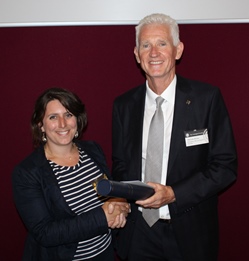 The William Smith Fund goes to Dr Hannah Hughes of the University of Exeter, Camborne School of Mines.
The William Smith Fund goes to Dr Hannah Hughes of the University of Exeter, Camborne School of Mines.
Hannah, an economic geologist and geochemist, studies the sources and budgets of chalcophile or ‘sulphur-loving’ elements and precious metals, to help us understand the controls affecting mineralisation in the Earth’s crust. She uses mantle xenoliths and sulphide inclusions in diamonds to probe the abundances of these materials at depth. She has also used lamprophyres to the same end, as well as studying the gases that they emit, sometimes explosively in mines.
Of particular interest to Hannah are the platinum-group elements or ‘PGEs’. The mobility of PGEs – some of the so-called ‘critical’ materials – is intimately connected with that of sulphur, and driven by processes of partial melting and metasomatism.
By linking xenolith, diamond and lamprophyre-based observations with the regional metallic fingerprints of Large Igneous Provinces, she has shown that metallogenesis in certain ore deposits may be controlled by previous tectonic events – so-called ‘preconditioning’ – which may have the power to change the ratio of metals in mantle-derived magmas, and thus their economics. This work has broad implications in the field of mineral exploration, as well as enhancing our understanding of deeper mantle and crustal processes.
Hannah has taken on a leadership role at an early stage of her career, as well as serving as Chair of the Applied Mineralogy Group of the Mineralogical Society, and on various science and conference committees.
Hannah Hughes, please accept with our compliments the William Smith Fund of the Geological Society of London.
Dr George Cooper (Murchison Fund)
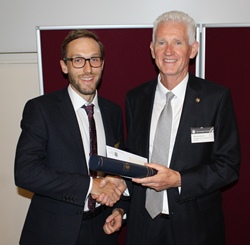 The Murchison Fund of the Society is awarded to Dr George Cooper of the University of Durham.
The Murchison Fund of the Society is awarded to Dr George Cooper of the University of Durham.
George Cooper’s research focuses on specific crystal studies – in particular, in situ microanalysis – in order to determine the pre-eruptive state of volcanic plumbing systems and the timing of the magmatic processes that lead to eruptions. This includes the use of in situ major and trace elements to indicate magmatic storage conditions and to establish the timescales involved, through Uranium – Lead dating in zircons, and diffusion modelling.
Notably, he has worked on the products of super-eruptions in New Zealand to determine the magmatic storage conditions and volcanic processes that lead to such large-scale silicic outpourings. His research at subduction zones includes the investigation of erupted plutonic xenoliths, in an attempt to investigate such processes happening deep in the plumbing systems beneath the Lesser Antilles island arc. Currently, his research is focused on the recycling of volatile elements through subduction zones, and is based on studying trapped melt-inclusions to determine the sources and pathways of fluids.
George Cooper, we are delighted to award you today the Murchison Fund of The Geological Society of London.
Dr Amanda Owen (Lyell Fund)
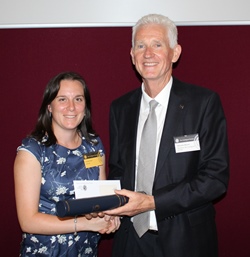 The Lyell Fund of the Society is awarded this year to Dr Amanda Owen of the University of Glasgow..
The Lyell Fund of the Society is awarded this year to Dr Amanda Owen of the University of Glasgow..
Dr Owen began her research career studying the Upper Jurassic Salt Wash Member of the Morrison Formation in the southwestern USA. This work enabled her to apply quantitative methods to the dissection of a Distributive Fluvial System (or ‘DFS’).
A pioneer in this field, her work has provided a template for further studies of these important sedimentary bodies. Such distributive fluvial systems comprise over 90% of modern-day continental basins, and it is likely that they have done so throughout much of geological time, which her current research in Wyoming and Spain is testing. Given their importance in the record, and as reservoirs, Amanda’s potentially predictive, scalable framework for understanding the down-system distribution of various crucial parameters (such as sand-body size, grain size distribution, and so on) is clearly a most valuable tool, and a useful benchmark for other workers.
Amanda has moved into mathematical modelling, developing algorithms (with Professor Peter Jupp of St Andrews University) to determine apex locations for any system with a point-source feed (such as deltas, or submarine fans) which has been applied to surface and subsurface datasets.
Amanda Owen, your original thinking leads you to solve conventional problems in unconventional ways, with significant scientific and potential economic impact. Please accept, with our congratulations, the Lyell Fund of The Geological Society of London.
Girls into Geoscience (R H Worth Award)
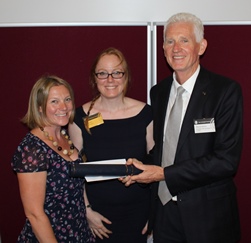 Moving on from the Funds, we come now to the R H Worth Award, which celebrates the practice and encouragement of geological science by and among amateurs. This year we are pleased to award it to an initiative, rather than one individual, Girls into Geoscience.
Moving on from the Funds, we come now to the R H Worth Award, which celebrates the practice and encouragement of geological science by and among amateurs. This year we are pleased to award it to an initiative, rather than one individual, Girls into Geoscience.
Girls into Geoscience is a significant geoscience initiative based at the University of Plymouth aimed at encouraging young women to take up a degree and a career in the geosciences. Their events are aimed primarily at Year 12 female students who are thinking of applying to university.
These exciting events (which are now residential) began in 2014 with the first Girls into Geoscience Day, which 65 girls attended. Field trips to see the local geology around Plymouth and Devon introduce female students to Earth sciences, and demonstrate the world of careers open to Earth science graduates today. Seminars from women currently working in geology – in both academe and industry – are complemented with hands-on workshops on a wide range of geological topics.
The aim of these events is to inspire and educate as well as foster a positive image for our science, encouraging more women into university geoscience courses where they have been historically somewhat under-represented.
There is no other UK initiative of this kind promoting geosciences specifically to young women, and Girls into Geoscience has been successful in attracting sponsorship and funding from, among others, BP, the Micropalaeontological Society and our neighbours across the courtyard – the Royal Astronomical Society.
And so, it gives me great pleasure now to present this Society’s premier outreach award to Dr Sarah Boulton and Dr Jodie Fisher, who will accept on behalf of Girls into Geoscience.
Sarah Boulton and Jodie Fisher replied:
Thank you, President, for presenting Girls into Geoscience with the R H Worth award, which we are delighted to receive on behalf of all the women who have helped make the event what it is today. From the rest of the organising committee composed of the staff and students at the University of Plymouth, the women who have given up their time to talk about their careers and industries, and of course the students and their teachers who come along every year.
We realised the need for such an event over five years ago, when we were increasingly worried by the low percentage of female students choosing to take Earth Sciences courses, not just at Plymouth, but also nationally. Unfortunately, it appeared that there was still the perception that Earth Sciences were not suitable for women; indeed, one female applicant told us that even her teacher had said to her that geology was only for boys.
Shocked by this statement, we decided that we would set up an event that would show both young women and their teachers that geology is an exciting, rewarding subject and career no matter what your gender. Thus Girls into Geoscience was born. Over the years we have had more than 250 girls attend, many of whom have gone on to study an Earth Science subject at university, and we hope to continue running the event until it is no longer needed.
Finally, we would like to thank our many sponsors without whom it would not be possible to keep the event free for the girls to attend. Thank you.
Dr Charlotte Adams (Aberconway Medal)
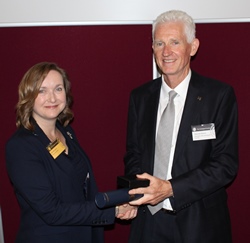 We come now to the Aberconway Medal, which this year is awarded to Dr Charlotte Adams of Durham University.
We come now to the Aberconway Medal, which this year is awarded to Dr Charlotte Adams of Durham University.
Dr Adams is a fellow at the Durham Energy Institute and a leading proponent of low-enthalpy near-zero carbon geothermal energy in the UK, and her work bridges the gaps between academe, industry and society. Her work focuses on demonstrating the technical feasibility, commercial viability and social acceptability of geothermal energy from flooded, abandoned coal mines and deep aquifers.
To this end in 2013 Charlotte co-founded BritGeothermal, the UK national research body for geothermal energy, and has managed it ever since. She has organised many workshops as well as their annual R&D conferences here at the Geological Society, bringing together practitioners, academics, local councils and government, to enable the exchange of ideas and development of networks that will, ultimately, de-carbonise the heating of the UK.
Charlotte worked closely with Lord Jenkin to change the recent Infrastructure Bill so as to decouple geothermal energy from the development of shale gas, redrafting the Bill’s appropriate Section. She is working currently with Spennymoor MP Helen Goodman and local resident groups to develop the geothermal potential of the flooded coalmines beneath the town. As well as attracting extensive media interest, this work has garnered international support from places such as Heerlen in the Netherlands where a similar system is in operation.
Charlotte Adams, your success derives from your ability to translate technical and scientific information into terms accessible to local community groups – groups who are now beginning to see a future n energy provision from the legacy of the abandoned coal mines above which they live.
Please accept with our compliments the Aberconway Medal of the Geological Society.
Charlotte Adams replied:
Thank you Mr President, and many thanks also to the Awards Committee, Council and nominators for this award. I feel most honoured to accept the Aberconway Medal; it was a wonderful surprise! I am very fortunate to be able to pursue a career doing something I love and wish that through my research and teaching, I will inspire others to do the same.
I have studied geology since I was 15, being fortunate to attend a school that offered this subject at GCSE and A-Level. My first field trip looking at minerals on the spoil heaps of Alston Moor fuelled an interest in minerals and mining which remains today and has also allowed me to diversify into other areas such as energy and water.
I must express my thanks to many people who have supported me over the years. To name a few, my Geology teacher, Ann Ashdown, who was an inspirational mentor and strong female role model; Dr Graeme Oliver, my undergrad dissertation supervisor at St Andrews University; Anne Lewis from the Environment Agency who was instrumental in developing a PhD opportunity at Newcastle University under the supervision of Professor Andy Aplin, who I’m pleased to say is now also at Durham; and Professor Paul Younger who sadly recently passed away but whose legacy will remain in all of us that he inspired. Following my PhD, I joined industry and had the pleasure of working under the guidance of Dr Rick Smith at his consultancy practice.
I gratefully acknowledge that in accepting this award, I am in extremely good company with the next people I thank having been both previous recipients of this award and supportive of my career. My first communication with Durham University was through Professor Bob Holdsworth, who is also here today and has been continually supportive of my work. I joined Durham University in 2009 under the enthusiastic leadership of Professor Richard Davies where I helped establish Durham Energy Institute. Professor Jon Gluyas joined Durham around the same time as me. Jon is both a generous and inspirational mentor and also a friend and has worked tirelessly to support my role at Durham.
On a personal note, I must also thank my husband Andrew, daughter Sophie and my parents for their continued support and encouragement.
I would like to close by saying that engaging with industry and undertaking applied research has not been an easy route to follow in academia, where often great emphasis is placed upon blue skies research. However, I have had the opportunity to witness many advancements in industry, particularly in the geothermal sector. With this in mind, I need to also thank the many people I have worked with across the industry.
I truly believe that there is huge potential for academia to work symbiotically with industry to deliver change and generate impact. The fact that this award recognises this activity and the boost I have received in being awarded it is something that will remain with me for years to come. Thank you.
Professor Simon Poulton (Bigsby Medal)
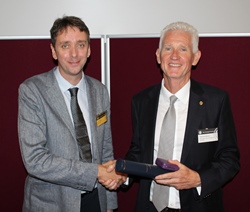 We come now to the Bigsby Medal, which this year is awarded to Professor Simon Poulton of Leeds University.
We come now to the Bigsby Medal, which this year is awarded to Professor Simon Poulton of Leeds University.
Professor Poulton is a biogeochemist who has been instrumental in re-writing the history of the Earth’s early oxygenation, and its links to biological, climatic and chemical evolution. In pursuit of this research he has developed new techniques for reconstructing the redox conditions of ancient oceans and atmospheres – techniques that have now become accepted as standard. Through laboratory experiments and via the detailed study of modern early Earth analogues, his work has established a more profound understanding of key biogeochemical processes. Applying this to the rock record, his approach has illuminated key events in the history of our planet, including major changes in the chemistry of the oceans, the oxygenation of the atmosphere, and controls on the origin and evolution of animal life.
A full-time researcher for almost 25 years, his PhD produced the first reconstruction of the modern global iron cycle, based on mineral speciation – work of wide-ranging relevance, from soil science to weathering and transport processes. It set the stage for the application of Fe-based redox proxies to reconstructing ancient environments.
Simon’s work led to the first identification of minerals such as ‘green rust’ in anoxic waters, probably a major control on nutrient availability in the ancient oceans. Simon also produced the first detailed reconstructions of ocean chemistry through the Proterozoic, demonstrating the persistence of anoxia and iron-rich conditions, which fundamentally altered our understanding of Earth’s oxygenation history, pushing back the timing of ocean oxygenation by more than a billion years. He has since gone on to shed light upon other cases of ocean anoxia, notably during the Cretaceous.
Simon Poulton, your service to geological research is of the highest level. Please therefore accept today, with our congratulations and confidence in the future, the Bigsby Medal of The Geological Society of London.
Simon Poulton replied:
Mr President, I am very honoured to win the Bigsby Medal and would like to express my sincere thanks to the Geological Society and those who nominated me.
I am particularly humbled because it took me some time to find terra firma as a geologist. In this regard, I would like to acknowledge one of my unsung heroes – the late Dr Colin Rowley of the University of Portsmouth. Colin introduced me to geochemistry, and it was his geochemistry lectures that first made me realise that there was a subject where I could combine my peculiar requirement for the precision of chemistry, with the vision that I felt was required, but which I lacked, as a geologist.
As a direct result, I subsequently chose to do a Masters in Geochemistry, which firmly set me off on my current path. Along the way, I have been fortunate to work with some wonderful colleagues, students and postdocs, many of whom have become great friends, and I am also very grateful for tremendous support from my family. There are too many people to thank, but I must single out my three main mentors.
My PhD supervisor, Professor Rob Raiswell at the University of Leeds, first got me passionate about marine mud and modern global elemental cycles. My postdoctoral advisor, Professor Mike Krom at Leeds, introduced me to experimental geochemistry and the importance of nutrients in the Earth system. I then moved to Denmark, where Professor Don Canfield taught me how I could take my skill-set and apply it to the rock record, thereby taking me full circle back to Geology. It is the combination of these approaches that I continue to find fascinating.
The Bigsby Medal is an acknowledgement of a mid-career scientist who essentially ‘still has much to do’. I certainly feel this way myself, and hope that I can do justice to this award in the future.
Mr David Shilston (Coke Medal)
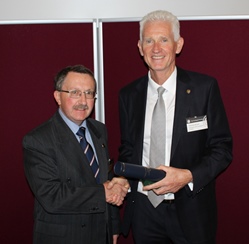 We now come to the Society’s two Coke medals, awarded to geoscientists who have made a significant scientific contribution and been of notable service to geology through activities of benefit to the community.
We now come to the Society’s two Coke medals, awarded to geoscientists who have made a significant scientific contribution and been of notable service to geology through activities of benefit to the community.
The first goes to Mr David Shilston of Atkins. David is well known in this building, having served as our President from 2012 to 2014. He has almost 40 years’ experience of engineering geological projects in the UK and overseas, being now Head of Discipline for Engineering Geology at Atkins. As a Chartered Geologist, a Chartered Scientist and a Registered Ground Engineering Adviser, he specialises in the management of geohazards and in resolving geological problems encountered in construction projects.
David’s distinguished professional career has been strengthened by his continuing support to the science of geology as a whole, for many years, being a tutor or visiting lecturer at universities so as to pass his knowledge onto the next generation – notably at University College London, the University of Edinburgh, and Imperial College. He was External Examiner for the engineering geology MSc at Leeds University, and is a member of the course’s Industry Advisory Board.
He lectures on diverse subjects from engineering geology and terrain evaluation, to landslides and mud volcanoes and has brought these topics to university students and to people at large through the Society’s Public Lectures.
At Atkins, David initiated and coordinated for almost a decade the Atkins Geotechnical & Tunnelling Scholarships. As a measure of its success, last year Scholarships were awarded to 22 university students to work in nine of the company’s UK offices.
David’s service to the Society, culminating in his Presidency, also includes important service as its Professional Secretary, a member of the Fellowship and Validation Committee, as a scrutineer of CGeol and CSci applications, and in memberships of Engineering Group working parties.
David is currently President of the Earth Science Teachers’ Association, in which role he is assisting the Association strengthen the links between schools and geologists working in industry.
From this rather scant survey, it is clear that David takes every opportunity to ‘give something back’, to the benefit of the science and profession – and hence also to society as a whole.
So, David Shilston; the breadth and depth of your service to geoscience and the community is almost unparalleled and render you a most worthy recipient of the Coke Medal of The Geological Society of London.
David Shilston replied:
Thank you, Mr. President.
We are all the products of our past; and the award of a Coke Medal has made me think about my past and how it led to me standing here today, saying my ‘thank yous’.
My earliest influences in a scientific direction were my father Michael, his brother Paul, and my school geography teachers. They introduced me to geology in various ways, from minerals and fossils to physical geology, which I have since learned to call geomorphology. I benefitted enormously from a broad education in geology at Nottingham University. As a general practitioner in engineering geology, I draw on that education frequently. In fact, I get my greatest pleasures in geology in going back to the basics – trying to read a landscape, understanding a cliff or quarry face; interpreting some borehole core.
Over the years, I have worked with and learned from many people with a wide range of backgrounds and skills. I will mention just one: Professor Peter Fookes, the recipient of the Geological Society’s first Glossop Medal for Engineering Geology. I owe Peter an enormous debt – for his technical guidance, encouragement, and intellectual generosity.
In other directions, I have enjoyed making links elsewhere – with schools and local geological societies for example.
There is, I think, a common theme in all of this, which I am sure many will share. It is that geology travels with you and is constantly fascinating, constantly posing questions.
But all of this is not without consequences. I have often been away from home. There was a time, some years ago, when my daughter asked me to stop bringing home white hotel slippers … and so, I have! My biggest thanks must, of course, go to my family, especially my wife Pauline and our children Robert and Catherine.
Professor Robert Holdsworth (Coke Medal)
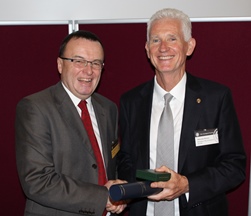 The second of the Society’s Coke medals is awarded to Professor Robert Holdsworth of Durham University.
The second of the Society’s Coke medals is awarded to Professor Robert Holdsworth of Durham University.
Bob Holdsworth is internationally renowned for his innovative research on continental deformation, delivering applications that deliver a range of innovative and fruitful applications. He is the founder and leader of one of the world’s leading structural geology groups, and with colleague Jon Davidson oversaw the emergence of Durham University as a leading centre for Earth Science. In addition, Bob has served on numerous committees of this Society, including Council, and of the Natural Environment Research Council. He has been an invited keynote speaker at 26 conferences, convened 27 others himself and edited 13 books. His 49 PhD students stand as a tribute to his wide-ranging work for the science, its applications and the geoscience community as a whole.
During the last two decades, Bob has made some of the most fundamental contributions to the subject of continental deformation in general, and fault reactivation in particular. His academic achievements extend from developing insights on fundamental aspects of hard-rock through to soft-rock deformation, as well as reconciling the deformation mechanisms of equivalent structures - like faults and shear zones - at different levels in the crust. This has been reflected in his outstanding contribution to Scottish geology, which won him the Clough Medal in 2018.
He has applied novel approaches in analysing the scale, connectivity, fluid transport history and dating of known reactivated faults onshore, as a means of deducing why some faults reactivate and others do not. His research here has not only bridged the academe-industry divide, but also the onshore-offshore divide: combining field analysis of reactivated faults in basement terranes onshore, with seismic interpretation and 3D datasets of the same faults offshore. The expression of reactivation on offshore cover successions has proved of great industrial relevance; while at the same time he has developed world-leading expertise on the connection between fault-rock properties and earthquakes, and hence hazard and risk-related studies – a new and exciting phase of research that has led to the establishment of the Durham Rock Mechanics Lab and publication in many leading journals worldwide.
Robert Holdsworth, these many contributions render you a worthy recipient of the Coke Medal of The Geological Society of London.
Bob Holdsworth replied:
It is a very great honour to receive this award from the Society after what has for me been a difficult year during which I have lost my father, Christopher, and soon, I fear, my mother Juliet at whose bedside I was just yesterday. It allows me to reflect that yes, I may have made a few contributions to science and worked in some wild and beautiful natural laboratories all over the world – but really it has all been about the relationships and communities that I have benefitted from and, in turn, have tried to nurture.
My geology teacher, Paul Hayler – who is with me here today – was the one who planted the seed and really got me going. His enthusiasm was infectious and it was he who first introduced me to the joy of working in the field. My PhD supervisors, Tony Harris and Mike Coward were lifelong influences in their very different ways. My career has been boosted by the influences of mentors and friends, including Juan Watterson, Rob Strachan, Clive McCann, Sue Treagus and Jon Davidson to name just a few. Key figures such as Tony Dore, Andy Conway, Robert Trice and Peter Ford have shown me of the importance of delivering research impacts beyond the academic sector.
I am proud to have helped Richard Jones and Ken McCaffrey launch our spinout company Geospatial Research Ltd in Durham. It is good to make a difference to the wider community, even in a small way. But my greatest professional debt is to my students and postdocs over the years. Without your hard work and loyalty, I would very definitely not be standing here today. It has been a privilege to work with you and to continue to help you when I can.
The greatest support for me comes from my wife Michele and sons Christopher, Thomas, Callum and Daniel. Michele, in particular, has had to suffer my many absences and some significant adversity during our time in Durham. Her support has been unwavering and to me this illustrates that behind the loyalty that has been my lifelong mantra there is something far more important – and that is love.
Professor Jan Antoni Zalasiewicz (Prestwich Medal)
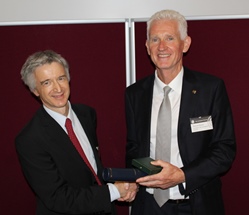 The medal named for Joseph Prestwich goes this year to Professor Jan Zalasiewicz of the University of Leicester.
The medal named for Joseph Prestwich goes this year to Professor Jan Zalasiewicz of the University of Leicester.
Jan Zalasiewicz is securing an enduring legacy of global scientific importance through his work as leader of the Anthropocene Working Group, the body investigating the stratigraphical signature of the Anthropocene, a new potential epoch within the international geological time scale, and the one in which humans have become the dominant geological and climatological force on Earth.
Jan is perhaps ideally suited to this task because his work is, and has always been, interdisciplinary. He is an authority on the stratigraphy of the Lower Paleozoic, has elucidated paleoenvironments and processes of the Quaternary ice ages and Holocene, and developed novel geophysics-based methodologies for geological mapping. He has even enabled this Society to achieve tabloid coverage for metamorphic petrology – hitherto universally regarded as an impossible feat - when his study of mineral growths in strain shadows surrounding graptolites, enabled geologists for the first time to date cleavage.
Jan’s advocacy of our subject has given birth to a series of fine popular books, including The Earth after Us, Planet in a Pebble, and Ocean Worlds. He has recently published an illustrated translation of Buffon’s Les Époques de la Nature of 1778, and so extended his reach into the history of geology.
However, it is as one of the leading stratigraphers of our age on which Jan’s reputation really rests, through the range and impact of his research. He has made startling contributions to, among other things: UK lower Paleozoic stratigraphy, through his globally important work in graptolite biostratigraphy; to the geology of mudrocks (including the recognition of new mineral phases and processes) and the devising of novel radiometrically-based monazite geochronometers; to mapping and characterising Quaternary deposits, resolving the centuries-old problem of lithostratigraphy of the Crag deposits of eastern England; to the development of novel, highly effective ground conductivity methods for mapping soft-rock terrains; to the practical and philosophical underpinnings of the international synthesis that is the Geological Time Scale; and to the development and critical analysis of the Anthropocene concept.
Jan Zalasiewicz, you have done so much, I have run out of time, alas, even to mention your many invaluable contributions to this Society! You have achieved a breadth of distinguished work almost unparalleled in an age of ever-increasing specialization. It therefore gives me great pleasure to confer upon you today the Prestwich Medal of The Geological Society of London.
Jan Zalasiewicz replied:
Very many thanks for those most kind and humbling words – and my thanks too to the Awards Committee and my nominators. This is a great honour – an occasion to treasure. It is a particular pleasure to be linked with Joseph Prestwich, whose work on the Crag-Beds of Essex and Suffolk published, of course, in the QJGS, made well-thumbed papers that colleagues and I used in our own struggles with the Crags. I later found out that Prestwich combined his geology with successfully wine trading, and in his student days he founded a Zetetical Society in London, whose purpose was to said to be to ‘organise working class infidels’. That’s an enviable and delightful range of activities.
My own trajectories across geology were partly response to circumstance. After a PhD on the north Welsh Lower Palaeozoic, and convinced I was a hard-rock man for life, I joined the BGS only to be instantly put on to the soft flat ground of eastern England, Prestwich’s Crags and all. Some years later, and spiritually refashioned for this terrain, the call came to return to the Palaeozoic of central Wales. After that I no longer knew what kind of geologist I was – except that it was all fascinating.
The only reason that I navigated this hairpin course is, of course, due to the infinite patience and kindness of colleagues worked with, and taught by, along the way. Among them were John Norton of Ludlow Museum, Harry Whittington and Barrie Rickards at Cambridge, and on the BGS to Leicester path, Steve Mathers, Jane Evans, Tony Reedman, Adrian Rushton, Mark Williams and Colin Waters, and very many more. To the enthusiasm and inspiration of my students and the support of my family I owe much too.
Not to forget the Society – it has been pretty much ever-present in my professional life, both haven and springboard for shared ideas, at the Stratigraphy Commission and elsewhere within its wide reach. I learnt here that a supportive spirit, critical rigour and adventurous ideas can go hand in hand. This has all been more than a little inspirational, and for that, and for today, I thank you all most deeply.
Peter Dolan (William Smith Medal)
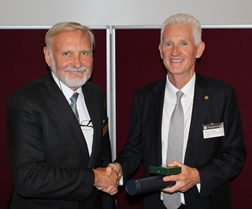 The medal named for William Smith celebrates outstanding achievement in the field of applied geology, and this year we are delighted to present it to Dr Peter Dolan of Ikon Science Limited.
The medal named for William Smith celebrates outstanding achievement in the field of applied geology, and this year we are delighted to present it to Dr Peter Dolan of Ikon Science Limited.
Peter has been involved in exploration and research for over half a century. After working for Mobil, he co-founded numerous consultancies including Dolan & Associates, JEBCO Seismic, IKODA and Ikon Science. He then co-founded four exploration companies; Virgo Exploration, Neon Energy, Fusion Oil & Gas and Ophir Energy. The aggregate value of these companies has been several hundred million pounds.
Peter studied geology at Southampton University and then, after a spell in industry, undertook a PhD in carbonate sedimentology at University College, London. His work since amounts to 45 years of exploring and advising many companies (as he still does), during which he has helped to initiate a number of new technologies. For example, the MIND project between IKODA and the Institute of Psychiatry at Kings College, funded by oil majors, which applied techniques and algorithms from FMRI technology to time-lapse 4D datasets, so that advanced image processing could help identify remaining reserves in producing oilfields. Latterly, as a board member, he has been involved with the many innovative seismic interpretation techniques developed by Ikon Science.
Peter’s work with Dolan & Associates led to numerous highly regarded publications dealing with the petroleum potential of scores of sedimentary basins around the globe.
For the past 25 years, Peter has been an active member of the Society’s Corporate Affiliates Committee. He co-founded the City of London Geoscience Forum, a prominent group which organises regular, geologically-focused meetings of interest to the financial sector in London, thereby forging strong links between that community and the Geological Society.
Yet amidst all this serious and important work, Peter has found time to entertain the readers of Geoscientist and the Society blog with items ranging in subject from the geology of beer to the meaning of those puzzling symbolic markings that pepper the older kerbstones lining the gutters of British cities.
Peter Dolan, it is my great pleasure to award you the William Smith Medal of The Geological Society of London.
Peter Dolan replied:
Mr. President, thank you for that fulsome and generous citation. I’ll respond in suitably ‘oily’ and commercial terms; since I have often said that oil runs in my veins, imagine me as a drop of oil:
- Source: Everything started with my geography master Basil (‘Wo’) Worthington at Colfe’s Grammar School in Lewisham who guided me towards geology at A-level. The extra-curricular weekend bike trips to Gault Clay pits near Wrotham, Kent, hunting for fossils in Beds I to XIII are halcyon memories; shades of Strata Smith.
- Maturation and Expulsion: After attending Southampton University, under the paternalistic eye of Prof. Frank Hodson, I emigrated to Canada to work for Mobil rather than accept an offer from the British Antarctic Survey; the first time I succumbed to Mammon. I soon learned that if I couldn’t sell my exploration prospect to management then it was worth nothing; we are all in the business of selling ide
- Migration: My PhD field work in the Caribbean, foreign postings to Libya and Indonesia as well as much business travel highlighted for me that, inter alia, the commercial concept of the ‘time value of money’ is rarely understood by bureaucracies.
- Entrapment: 20 years of developing consulting companies delivering projects trapped by time and budget constraints taught me many pragmatic commercial imperatives.
- Production: Thereafter, raising private capital to start E&P companies, gave insights into the mysteries of markets and investors. These experiences led me to the Corporate Affiliates Committee in the 1990s when corporate sponsorship came mainly from the petroleum industry. Then, in 2011, an epiphany; the realisation that the financial community benefits hugely from the resource sector, hence the City of London Geoscience Forum was founded. Hopefully, these efforts have benefitted the Society in its engagement with the commercial world.
- Depletion and Abandonment: Still a distant prospect, I hope.
Mr. President, my sincere thanks for the humbling award of the William Smith Medal go to many in the Society and the mostly younger and certainly more technically savvy colleagues who have helped me in my career; they know who they are.
I hope I can continue to be worthy of the Medal named after one of my most cherished heroes.
Professor Janne Blichert-Toft (Murchison Medal)
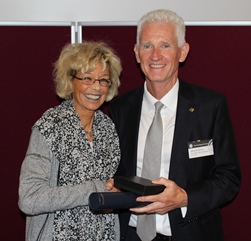 We bestow the medal named for Sir Roderick Impey Murchison on Professor Janne Blichert-Toft of the École Normale Supérieure de Lyon.
We bestow the medal named for Sir Roderick Impey Murchison on Professor Janne Blichert-Toft of the École Normale Supérieure de Lyon.
Janne Blichert-Toft is one of the leading figures in her field through an impressive body of highly cited work in the fields of isotope geochemistry and geochronology and has already received numerous accolades for her contributions to our understanding of the early history of the Earth and Solar System.
Janne Blichert-Toft has made fundamental contributions to our understanding of crust-mantle evolution and the chemical composition of matter in the universe. These have included developing major techniques, especially for hafnium isotopes, and the use of high-temperature radiogenic isotope geochemistry, with applications to: geochronology, terrestrial and planetary mantle-crust evolution and mantle dynamics, the evolution of the early Earth and the growth of the crust – as well as cosmochemistry and meteoritics.
Her research over the past 20 years has dramatically changed the scale on which isotopic work is now being done, analysing hundreds of samples with high spatial and temporal resolution, hence allowing meaningful statistical data assessment. She has applied this approach to mantle geochemistry, using hafnium, neodymium, lead and strontium isotopes. She pioneered lutetium-hafnium dating, a powerful chronometer for unravelling tectonic histories. Using lead isotopes, she has dated refractory inclusions in meteorites, defining the age of the Solar System; re-determined the 45-year-old initial lead-isotopic composition of the Solar System with greatly increased precision; found the first time-absolute lead-isotopic evidence that some asteroids coalesced within only a million years of the Solar System’s formation, placing major constraints on nebular evolution; and for the first time measured the Solar System’s thorium/uranium ratio at high precision.
In a series of papers spanning almost her entire career since 1994, using hafnium, neodymium, lead and osmium isotopes – including extinct radioactivities – she has significantly advanced our knowledge of processes and timescales during the first two billion years of Earth history, during which our initially hot and inhospitable planet became home to life.
Janne Blichert-Toft, your work record is profound, diverse and characterised throughout by important papers on significant topics. This is the record of a leading scientist and you are indeed a worthy recipient of the Murchison Medal of The Geological Society, which it is my great pleasure to present to you now.
Janne Blichert-Toft replied:
It is with great pleasure that I receive this award today from the prestigious Geological Society of London. I am deeply honoured and delighted, but also profoundly humbled, to join the ranks of the impressive long line of distinguished past recipients, no less than 146 eminent geologists before me (including Arthur Holmes in 1940!) from all fields within the hard rock sciences, and….wait for it….two of whom are women (in 1919, the first year women could be elected to the Society by change of the by-laws, and again the following year, in 1920….apparently two palaeontologists working together). So here I am, almost 100 years later to the date, only the third woman ever to receive this award. Which of course makes it an even greater honour. And also proud to be breaking with tradition!
So the Society cannot be accused of bestowing their medals based on gender rather than merit and for that, as a woman, I am truly grateful. I say this because, by now, it is probably not lost on you that, in these new times of forced gender parity and women quotas, whenever something good happens to a woman now, such as receiving an award or being promoted or getting a proposal funded, she cannot help but doubt whether she got this because she really deserves it for her work or because she is a woman, and that is the unfortunate, but of course completely unintended, collateral damage from trying to support women, which in and of itself is a noble quest.
When I received the letter informing me that I was going to receive the 2018 Murchison Medal, that was once again, as at other such occasions during my career, exactly my first thought, but then, when I saw the Society’s track record on prior women recipients of the Murchison Medal, I instantly felt reassured! More seriously, I completely trust my nominators and the Society’s nominations and award committee to ensure that their first concern and priority in bestowing the Society’s honours is merit, certainly something we have witnessed here this afternoon among this year’s many brilliant Society award winners. Only a woman can say what I just said so when I prepared this acceptance speech I thought I would seize the unique opportunity I have here today to have your full attention and speak on behalf of many of my women colleagues. Also just in case it will take another 100 years before another woman will stand at this lectern to receive the Murchison Medal!
Now, back to the task at hand. Being a high-temperature isotope geochemist I was at first puzzled by being awarded a “hard rock” medal in the name of one of the fathers of the early Paleozoic stratigraphy working primarily on sedimentary rocks. I must confess that until today I never really thought of sedimentary rocks as “hard rocks”. But then I thought about it some more and realized that we, Sir Murchison and I, do have common ground and what it is: What we have in common is our relentless quest for time keeping without which we would not know anything about our planet’s long history as recorded by rocks, minerals, and fossils. Admittedly, while stratigraphy is about relative time keeping, I am mostly into absolute time keeping, and we also do use very different methods, sedimentary strata and fossils, on the one hand, versus igneous rocks, meteorites, and radiogenic isotopes, on the other hand, but still, this is common enough ground for me to accept this honour today without feeling completely unworthy of following in Sir Roderick Impey Murchison’s footsteps.
Being an isotope geochemist is a lonely job. One spends hours, days, weeks alone in the clean lab and on the mass spec. Nevertheless, the work I am being honoured for today, I did not do it alone and I owe thanks to many.
First of all, I would like to thank the Society and those who nominated me for this incredible distinction and great honour. Then I would like to thank my Masters and PhD advisors who got me started on the path I have been on ever since and who were great sources of inspiration and challenge, and my first encounter with scientific creativity and rigor.
I am further grateful to the CNRS for making what, at the time, seemed a great leap to hire me in France, and the Ecole Normale Supérieure for having hosted me in Lyon ever since. I am deeply indebted to Rice University for having appointed me as a proud Distinguished Wiess Visiting Scholar and Adjunct Faculty and for literally having adopted me into their Earth Science family for the last ten years. I also thank profoundly my brilliant students and many collaborators worldwide. I would not be the scientist I am today without you. Finally, I want to especially thank Philippe Telouk, our world-renowned engineer who heroically brought multi-collector ICP-MS past 2V/ppm of Hf in the mid-‘90s, and Francis Albarède, my husband and sometimes collaborator, without whom multi-collector ICP-MS would not have existed in the first place and without whose boundless love and support I would not have made it this far intact.
Before I finish I just want to share with you a small twist to today’s event that makes it even better than it already is: Terry Plank and I were grad students together at Lamont in the late ‘80s and early ‘90s… If anybody back then had told us that one day, almost 30 years into the future, we would be sharing this event together at the Society in London, I don’t think we would have believed it. So this only adds to an even more amazing day for me.
Thank You, Mr President, Thank You, All!
Professor Julian Andrew Dowdeswell (Lyell Medal)
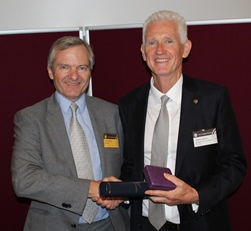 The medal named for one of the 19th Century's most influential geologists, Sir Charles Lyell, goes this year to Professor Julian Dowdeswell of the Scott Polar Research Institute, University of Cambridge.
The medal named for one of the 19th Century's most influential geologists, Sir Charles Lyell, goes this year to Professor Julian Dowdeswell of the Scott Polar Research Institute, University of Cambridge.
Director of the Scott Polar Research Institute since 2002, Julian Dowdeswell is arguably the leading glacial geologist/glaciologist in the UK today, and a world leader in the field of glacier-influenced marine sedimentation. His publication record is outstanding, including 350 papers and 10 books (including three for this Society, the most recent being among its biggest!).
During his career he has founded internationally renowned centres of glaciology in the universities of Aberystwyth and Bristol, and has supervised dozens of graduate students and post-docs. All this has been accompanied by notable contributions to the geoscientific community worldwide. Scientifically, Julian Dowdeswell's work has covered glaciological investigations into the form and flow of ice-sheets, focusing particularly on field studies of high-Arctic ice-masses and their response to climate change. He has investigated processes and patterns of glacial sedimentation in marine environments, emphasizing the links between geophysical measurements and numerical models of sediment delivery to the continental margin.
Third, he has conducted satellite remote sensing studies of large ice masses, in particular undertaking quantitative analyses of these data to solve glaciological problems and provide boundary conditions for numerical models of ice-sheet dynamics.
This is not the sort of research that can be done on a shoestring, and Julian has been able to do these things through obtaining almost £12 million worth of research grants, which he has used to fund some 40 scientific cruises, airborne and land-based field programmes in the Canadian Arctic, Greenland, Svalbard, the Russian Arctic, Patagonia and Antarctica - in many cases as expedition leader. He has pioneered the use of geophysical equipment, and introduced numerous PhD students and post-docs to marine geology and geophysics. Many of them are now similarly, leaders in their field.
This work culminated in the 2016 publication by this Society of a ground-breaking volume, the Atlas of Submarine Glacial Landforms - a huge memoir; a monument of science and an almost superhuman effort of editing.
Julian Dowdeswell, it is my great pleasure to award you now the Lyell Medal of The Geological Society of London.
Julian Dowdeswell replied:
Thank you, Mr President, for your very kind words.
First, it is a pleasure to thank the Geological Society for the award of the Lyell Medal - I am delighted, honoured and humbled to receive this award, especially as one whose career began with a Geography first degree.
It has been a huge privilege to be a field scientist who has worked in both polar regions over almost four decades – I first went to Iceland in 1979 for my undergraduate dissertation fieldwork, looking at sedimentation on the western margin of the Vatnajökull ice cap.
My glaciological and glacial geological research has taken me to many parts of the Arctic and Antarctic. I have spent long periods both on the ice itself and also at sea on icebreaking research vessels in Arctic waters and the Southern Ocean. I have felt huge awe in working in some of the most remote and wild places in the World and in visiting, for example, the isolated hut at Cape Evans from which Captain Scott and his four companions set out for the South Pole over a hundred years ago – never to return.
0
My work has not only given me access to these special places, but has also allowed me to add, in a small way, to our understanding of the icy world past and present and how its changing nature is, in turn, affecting humankind through sea-level rise and changing ocean circulation.
I have been very lucky with both my teachers and my academic colleagues. My school teachers, John Barrett and Nigel Bates, gave me a superb start – this is such a vital time for any young person, yet teachers seem to be undervalued in modern society. My undergraduate Director of Studies in Jesus College Cambridge, Robin Donkin, provided a rigorous grounding in analytical and writing skills. The supervisors of my masters and doctoral research, John Andrews in Colorado and David Drewry at the Scott Polar Research Institute, passed on their interest in and love of the polar regions to me.
More recently, I have also been fortunate to work with many talented research students and post-docs, a number of whom have gone on to their own academic posts in the UK and abroad. This has been particularly rewarding, as these women and men represent our academic future.
Finally, I want to thank my wife and academic colleague, Evelyn (herself a geologist), our two children Vicky and Adam, and my parents, for their strong and steadfast support of me through an academic career which has meant that I have been away in the Arctic or Antarctic for long periods of field work.
Mr. President, thank you once again for the award of the Lyell Medal.
Professor Robert William Hope Butler (Dewey Medal)
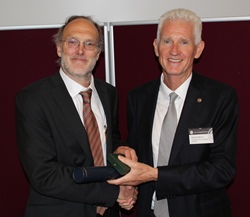 Before we reach the climax of today’s proceedings with the award of the Society’s highest honour the Wollaston Medal, we come to the first ever presentation of a new medal, made possible by a generous endowment from Professor John Dewey – and henceforth to be known as The Dewey Medal.
Before we reach the climax of today’s proceedings with the award of the Society’s highest honour the Wollaston Medal, we come to the first ever presentation of a new medal, made possible by a generous endowment from Professor John Dewey – and henceforth to be known as The Dewey Medal.
The Dewey Medal is a lifetime achievement award, given to a geologist who has championed the use of classical geological mapping methods - exemplified by the design on its reverse, showing the familiar accoutrements of the field geologist – boots, hand lens, compass-clinometer, and of course, hammer.
The first Dewey Medal is awarded to Professor Rob Butler of the University of Aberdeen.
Rob Butler is well known across the European geological community and worldwide as an outstanding field geologist. His scientific work has spanned the tectonics of fold and thrust belts (in the Alps, Scotland and the Apennines), basement tectonics (in the Himalayas) to deep-water sedimentology (in the Apennines and New Zealand). In all these subjects Rob has published pioneering papers, some of which are true benchmarks. Within the Italian geological community in particular he is renowned both for his in-depth knowledge of Italian geology, and for the well-known field-geology training which he has offered for many years.
As well as being himself an outstanding field geologist and dedicated teacher, Rob has promoted structural and field-geology techniques to more than three generations. His critical thinking and innovative, multidisciplinary approach always aims to test hypotheses through careful observation of field relationships, geological map compilation at different scales, and balanced cross-section construction and restoration. By dint of these traditional techniques applied rigorously in a modern context, he has produced some of the most interesting interpretations and models in Alpine and Apennine geology.
His contributions on Inversion Tectonics in the Apennines represent a now classic view. His tested interpretations for the western Alps’ deep geometry represent a benchmark in tectonics. More recently, his papers on Messinian geology - but also on deep-water depositional systems in the area of Sicily - have critically questioned and challenged accepted interpretations.
Rob has taught - and is still lecturing to - generations of geologists around the world and gives seminars, keynote lectures and field classes both for academics and commercial geologists. He has also promoted the need to preserve our geo-heritage, particularly from destruction at outcrop by extensive and invasive sampling, introducing several concepts that are now well accepted within the geoheritage community.
Rob Butler, you have disseminated practical geological field knowledge throughout your entire career and you are globally recognised for this work - a remarkable leader, promoting fields and methodologies that have had major impacts on future generations, for the benefit of the society. It is my great pleasure therefore to present to you the first Dewey Medal of The Geological Society of London.
Rob Butler replied:
Mr President, Council and my nominators – thank you very much for this great and surprising honour. But I’m not sure about a lifetime achievement award – I’d rather see it as a mid-career or even late-early career thing.
And of course, thank you to John Dewey for establishing this Medal. Like John I am passionate about fieldwork. As he always says: the truth lies in the rocks. We both work on continental tectonics, using the geological record to deduce tectonic processes. Fieldwork is central to these endeavours. The geometric relationships between different rock units are critical here – get this wrong and other geological data can be very misleading. It was true two hundred years ago and remains true today. It’s important to use lots of evidence – I liken fieldwork to doing a crossword puzzle – if you can’t solve one across, try another part of the puzzle – get more clues, different ideas.
HH Read is generally credited with coining the maxim “the best geologist is the one who has seen the most rocks”. I disagree – it’s not just about seeing. That is simply Earth Observation. We need to be doing Earth Interpretation. So it’s about generating interpretations, challenging these with observations and data and modifying them accordingly – or throwing them away. The field is a great place for going around this loop of scientific method. I had the enormous benefit of being in Leeds in the late 1970s and early 80s, where I was trained (more like empowered) by Mike Coward. He had the remarkable ability to generate hypotheses and change them – sometimes seemingly on an hourly basis.
Of course, developing understanding of continental tectonics involves far more than structural geology. I’ve benefitted hugely from working with great Earth Scientists across a whole range of disciplines: geophysics; geochemistry; igneous and metamorphic geology; palaeontology and stratigraphy; sedimentology – both carbonate and clastic (or should that be iconoclastic). Thank you all. And thank you again to the Society for this great honour.
Professor Terry Plank (Wollaston Medal)
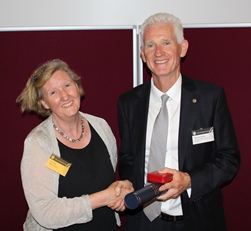 Finally, we come to the Wollaston Medal - the Society's senior medal and highest accolade, first awarded to William Smith in 1831. Today this most prestigious award goes to Professor Terry Plank.
Finally, we come to the Wollaston Medal - the Society's senior medal and highest accolade, first awarded to William Smith in 1831. Today this most prestigious award goes to Professor Terry Plank.
Terry Plank, Arthur D Storke Memorial Professor in the Department of Earth and Environmental Sciences at the Lamont Doherty Earth Observatory, Columbia University, is a geochemist and igneous petrologist who studies magmas associated with the plate tectonic cycle. During her illustrious career she has made major contributions to our understanding of the subduction process in particular, by employing chemical tracers to study how magmas form in the mantle, how the continental crust grows, and how the Earth chemically evolves.
In a series of now-classic papers, Terry Plank explored the systematics of mid-ocean-ridge basalts and arc volcanoes to quantify the roles that decompression, mantle temperature and water content play in driving mantle melting. Her most cited work addresses the sediments subducted along with the down-going plate in subduction zones, and calculates their global budget of chemical tracers. From these distinctive geochemical fingerprints, she traced sediments from the sea-floor through the subduction process and out into the volcanoes of island arcs. This work has had a profound impact on the way we understand how material cycles from the exterior of the Earth to its interior.
More recently she has been involved in determining the water concentration in magmas prior to their eruption, by analysing tiny inclusions of melt trapped inside volcanic crystals. This water is very important because it is responsible for driving both melt-formation in the mantle, as well as explosive eruptions. She has shown how the water content of magmas before eruption is much more uniform than previously thought, and unlikely by itself to explain large variations in eruptive behaviour. Currently, she is exploring the use of chemical diffusion at micron-scales to constrain the minutes-to-hours of magma ascent prior to explosive eruptions.
Terry Plank, you are a profoundly important figure in science today. Your highly cited work has already been recognised by a number of other societies, including membership in the National Academy of Sciences in the USA, Fellowship in the American Geophysical Union and Geological Society of America, and as a medallist of the European Association of Geochemistry.
It therefore gives me the greatest pleasure to acknowledge your outstanding achievements to our subject by conferring upon you now the Wollaston Medal of The Geological Society of London.
Terry Plank replied:
I was born in a rock quarry in Delaware (in the US) and by grade school was collecting minerals – garnets and sillimanite – in the backyard. I am grateful to my father for building a house in a rock quarry and my mother who did her Master’s thesis on those rocks. I mapped my first subduction zone pluton when I was 16, on the grounds of my High School. I have had little imagination throughout my career. I was born to the subduction zone, and as my friend Francis Albarede likes to point out, I have never left the subduction zone.
I came of age as a graduate student at Lamont in the late 1980s. So much had happened the decades before during the Plate Tectonics revolution, it definitely felt like the dirty dishes and sticky floor after the party. But the 1980s were exciting too – this is when plate tectonics became a geochemical cycle. Al Hofmann, Bill White and Chris Hawkesworth’s work on recycling subducting slabs had an enormous influence. And so of course did Charlie Langmuir, Emily Klein and Dan McKenzie’s work on mid-ocean ridges – they were not just moving the plates, but creating them. Charlie instilled in me a global view and we share a love of discovering systematics in data. We worked together thinking about melting under arcs, and then what happens when sediments subduct. This took me to sea, drilling holes in the seafloor with John Ludden, who taught me how to have fun while being a co-chief scientist.
It was a Goldschmidt Conference in 2005 when Jon Blundy gave a talk about Mt St Helens, and how petrology drives volcanic eruptions. This was inspirational to me and changed the course of my research. I have had such a blast learning about volcanic eruptions and chasing magmatic water alongside students and postdocs, who know they are the joy of my professional career. It has also been wonderful to have returned to Lamont as a member of the faculty, and I thank Steve Goldstein, Dave Walker, Peter Kelemen and others who made that happen. I am honoured to follow Lamont Wollaston award winners, Maurice Ewing, Wally Broecker, and my great friend Maureen Raymo, the first woman recognized with this award.
Wollastonite is a mineral found in skarns – born of magma intruding sediments and driving off CO2. Having had a career in the space between igneous rocks and seafloor sediments, and now volatile loss during eruption, I feel a connection to this namesake mineral of Wollaston. Thank you so much to the President and members of the Society. I am humbled by this recognition, grateful to those who have supported me, happy to be sharing the stage with my friend Janne, and sharing this moment with friends, colleagues and especially my son, Sam.